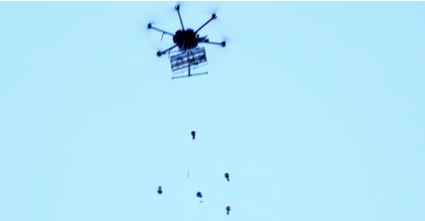Fully autonomous drone was used to ‘hunt down’ soldiers, UN says
LOS ANGELES - Last year, an unmanned Turkish drone may have "hunted down and remotely engaged" retreating Libyan soldiers, according to a U.N. Security Council report published on March 8.
The alleged attack occurred on March 27, 2020. The U.N. said the "lethal autonomous weapons systems were programmed to attack targets without requiring data connectivity between the operator and the munition."
The drone which was used in the attack was identified by U.N. officials as the Kargu-2, a rotary-wing attack drone that can be used autonomously or manually by a single person, according to Savunma Teknolojileri Mühendislik (STM) the Turkish company which designed the autonomous attack robot.
"KARGU, which is included in the inventory of the Turkish Armed Forces, enables soldiers to detect and eliminate threats in a region, and can be used easily by the soldiers in the area without entering the risky areas, especially in asymmetric terrorist operations and asymmetric warfares," the company says on its website.
The drone is capable of "real-time image processing capabilities and machine learning algorithms," which allow it to fulfill military operations completely on its own as demonstrated in a video provided by STM.
The U.N. report did not confirm any deaths related to the drone attack.
Zachary Kallenborn, a warfare and drones expert who writes for the Bulletin of Atomic Scientists, a nonprofit organization that works with Nobel Laureates to determine existential threats for humanity, said "if anyone was killed in an autonomous attack, it would likely represent an historic first known case of artificial intelligence-based autonomous weapons being used to kill."
Drones have been introduced onto battlefields across the globe as a means to limit human casualties and the overall costs of war.
But the benefit to such weaponry does not mean there isn’t a price to pay for either side using them.
The United States has come to rely heavily on drones to engage with terrorist organizations but there has never really been any comprehensive count of civilian casualties from drone strikes because of the difficulty in confirming identities and allegiances of those killed, according to a 2018 Associated Press report on militants and non-militants killed by drones.
In an examination of drone strikes in 2018 during Yemen’s ongoing civil war, the Associated Press found that at least 30 people who were killed in drone strikes were likely not affiliated with the terrorist organization the U.S. military was targeting.
Drones had initially been an expensive military luxury exclusive to wealthy countries like the U.S. But now, they are becoming cheaper and more accessible.
In 2019, news broke of a highly advanced drone belonging to the U.S. military with a hefty price tag of around $180 million that was shot down by Iran.
The drone was a U.S. Navy RQ-4A Global Hawk, typically used for high altitude reconnaissance missions with a wingspan of 130.9 feet, larger than a Boeing 737.
The autonomous drone described in the recent U.N. report weighs roughly 15 pounds, and while it does not have the same capabilities as the RQ-4A, the new pieces of weaponry are being used by entities in wars that may not have previously had the resources to afford them.
In mid-April this year, a drone targeted U.S.-led coalition forces near a northern Iraq airport, causing a large fire and damage to a building. There were no casualties. In late May, Marine Gen. Frank McKenzie, the top American commander for the Middle East told reporters traveling with him that the use of small drones by Iranian-backed militia is only going to grow in the next few years.
The drones, which are cheap and easy to buy, are often difficult to detect and problematic to defeat. McKenzie said the U.S. must find more ways to counter their use by America's enemies in the Middle East and elsewhere.
"We’re working very hard to find technical fixes that would allow us to be more effective against drones," McKenzie said. Efforts are underway, he said, to look for ways to cut command and control links between a drone and its operator, improve radar sensors to quickly identify the threat as it approaches, and find effective electronic and kinetic ways to bring them down. He added that fencing and high netting can also be used as protective measures.
"We’re open to all kinds of things," he said. "The Army is working it very hard. Still, I don’t think we’re where we want to be."
Because of varying concerns about lethal autonomous weapons systems, otherwise known as LAWS, the U.N. has released "guiding principles" on their use on the battlefield. Governments within the U.N. are still debating whether or not new restrictions on drones will be necessary as they become more and more common in warfare.
The U.N. principles were released following a recommendation The Convention on Certain Conventional Weapons in 2019 which determines types of weapons that members of the convention deem "inhuman."
While the recent drone attack in Libya was reportedly implemented autonomously by a machine, the U.N. states in accordance with its guiding principles that "accountability cannot be transferred to machines."
"International humanitarian law continues to apply fully to all weapons systems, including the potential development and use of lethal autonomous weapons systems," the U.N. writes.
This story was reported from Los Angeles. The Associated Press contributed.


